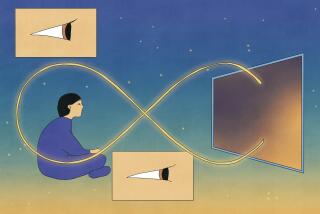Binge-viewing is transforming the television experience
- Share via
When Thomas Toth contracted pneumonia, he became inseparable from the cool, stylish Don Draper.
Toth watched all five seasons of the AMC series “Mad Men” from his sickbed in a two-week viewing binge . He became so captivated by its fictional admen that he began sporting skinny ties and drinking Old-Fashioned cocktails.
“The nuances of the story lines are getting so complicated — they’re introducing characters in Episode 2 and that character comes back in Episode 6 — I can digest things a lot quicker and easier when I binge on them,” the 44-year-old Denver resident said.
Toth has lots of company. Services such as Netflix and Hulu, as well as digital video recorders, have transformed the TV viewing experience by enabling viewers to devour multiple episodes or even entire seasons of “The Wire” or “Downton Abbey” in marathon viewing sessions.
Now Netflix is making a massive bet that it can satisfy the addiction that it helped create. At 12:01 a.m. Friday the service debuted its first original series, a political drama called “House of Cards” that stars actor Kevin Spacey as a ruthless, scheming House majority whip.
In a departure from television tradition, the entire season of “House of Cards” — all 13 episodes, nearly 13 hours of tense Capitol Hill drama — will be available at once, with the click of a button.
Millions of Americans are binge-viewing serialized dramas and comedies, including those that can no longer be found on the network prime-time schedule. Hits like the espionage thriller “24” and cult favorites such as “Arrested Development,” which both ran on the Fox network, have found new life on Netflix, as have past seasons of FX’s “American Horror Story” and ABC Family’s “Pretty Little Liars.”
The phenomenon is so pervasive that a majority of Americans ages 8 to 66 say they’ve engaged in this sort of copious TV consumption, according to a study conducted by media consultant Frank N. Magid Associates Inc.
“We’re finding that people who binge-view once binge-view again,” Magid Executive Vice President Jack MacKenzie said. “It’s the ‘you can’t eat just one’ kind of thing.”
This instant-gratification approach flouts network scheduling traditions.
Hollywood has always fed audiences a diet of, “Wait a week and we’ll give you new episodes, then wait a season, we’ll give you another season,” Netflix Chief Content Office Ted Sarandos said.
“The Internet is attuning people to get what they want when they want it,” Sarandos said. “‘House of Cards’ is literally the first show for the on-demand generation.”
Netflix committed a reported $100 million for two seasons of “House of Cards,” based on a strong script and the pedigree of the creative team of director David Fincher (“The Social Network” and “Fight Club”) and writer Beau Willimon, who received an Oscar nomination for the 2011 political drama “The Ides of March.”
“We wanted to go all-in,” Sarandos said. “It’s important to signal … that we’re moving into this space in a meaningful, big way. So we did it loud.”
If successful, the gambit could begin to unwind 60 years of serialized television convention — especially if others begin to emulate Netflix’s approach. So far, broadcast and cable programmers have shown no inclination to release multiple episodes simultaneously.
“I don’t think one show changes the television industry,” said Richard Greenfield, media analyst with BTIG. But “if this become replicated multiple times over by Netflix and others, absolutely.”
The instant-availability formula dispenses with cliffhangers designed to prevent the audience from fleeing during commercial breaks and woo them back for next week’s installment. There is no need for comprehensive recaps of the previous week’s episode because Netflix assumes that viewers won’t miss a beat.
The absence of ads means that each episode has more time for story lines and relationships — as much as 15 more minutes of story per television hour.
“We’ve been impacting how people watch and when they watch,” Sarandos said. “But ‘House of Cards’ is the first thing on Netflix that’s ever been actually crafted to be watched in multiple episodes. So there’s no catch-up. There’s no exposition. There’s no ‘previously on’ or ‘next on.’”
Modi Wiczyk, co-chief executive of Media Rights Capital, the independent studio that financed and produced “House of Cards,” said Netflix won the right to distribute the series because it gave the creators total artistic freedom.
PHOTOS: Hollywood Backlot moments
Its two-season, 26-episode commitment created a huge canvas for storytelling and gave the creators a shot at being a network-defining show, in the mold of HBO’s “The Sopranos” or FX’s “The Shield.”
“This is going to be part of the continuation of this story of the change in how people consume content,” Wiczyk said.
Fox executives first noticed the binge-viewing phenomenon with “24” as fans bought DVDs of the Kiefer Sutherland drama, with some people watching multiple episodes in a single weekend.
Netflix said the practice exploded with “Breaking Bad,” the AMC drama starring Bryan Cranston as a cancer-ridden chemistry teacher turned meth dealer. The service found that 74% of subscribers who began with a single episode of the first season ended up watching the entire run. The percentages were even higher when Netflix studied subsequent seasons.
Vince Gilligan, creator of “Breaking Bad,” said these changing viewing habits are liberating writers from the conventional wisdom that individual TV episodes should be self-contained and stand on their own. “Breaking Bad” broke those rules and has seen its viewership grow every season, which is unusual for a serialized drama.
“I’d love to attribute that to how wonderful a show we have,” Gilligan said. “But if I’m being honest, I realize we’re riding a wave, a very new wave, that has been very beneficial to us and to other serialized shows.”
To be sure, all-you-can-eat viewing is not a new phenomenon.
Networks broadcast TV “marathons” to provide catch-up viewing and create anticipation for a new season of a returning show. The boxed set, containing a complete season’s worth of TV shows, has made for countless lost weekends.
The DVR made it possible for viewers to record an entire season’s worth of a show, to be watched in big gulps later. Some viewers even record a whole season of a new show without watching a single episode until they’re all recorded. If they don’t like the first episode they abandon the series. If they do, they spend a weekend bingeing.
But binge-viewing threatens to shake up television’s status quo. Along with the DVR, it’s another harbinger of the end of the time-honored network schedule, when executives dictated when viewers could watch a favorite show, said Jeffrey Cole, director of the USC Annenberg School Center for the Digital Future.
“It’s the viewer saying, ‘I will watch it how I want to watch it — in some cases without commercials,’” Cole said. “It’s television on my terms.”
Many television executives embrace the new opportunities for shows to find audiences. On-demand services like Netflix and Amazon.com’s Amazon Prime build anticipation and viewership for the new seasons of serialized dramas, AMC President Charlie Collier said.
Some advertisers may encourage the binge-viewing habit too. Viewer obsession with serialized dramas could fuel production of the next “Friday Night Lights,” a show whose loyal following was too small to keep the show on the prime-time schedule.
With the chance of another life, more dramas could get made, said David Scardino, entertainment specialist with the ad agency RPA.
But amid these changes, Collier says the nightly prime-time lineup is still a potent way to reach viewers.
“We put a lot of credence into the fact that the water-cooler event still exists on live, linear television,” Collier said.
“We’re seeing five years of growth in a row on ‘Mad Men’ and ‘Breaking Bad,’” he added. “Millions of people are coming to our air to celebrate that event.”
Times staff writer Meg James contributed to this report.
MORE
INTERACTIVE: TVs highest paid stars
ON LOCATION: People and places behind what’s onscreen
PHOTOS: Hollywood back lot moments
More to Read
From the Oscars to the Emmys.
Get the Envelope newsletter for exclusive awards season coverage, behind-the-scenes stories from the Envelope podcast and columnist Glenn Whipp’s must-read analysis.
You may occasionally receive promotional content from the Los Angeles Times.






